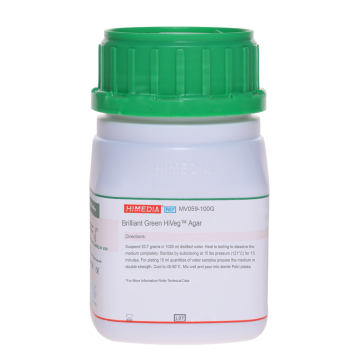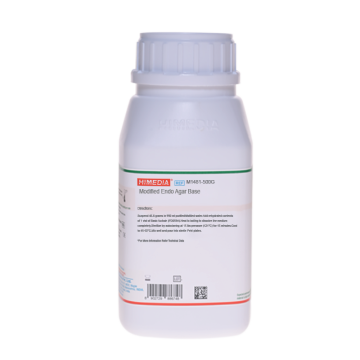 Your enquiry has been submitted
Your enquiry has been submitted
Brilliant Green Bile Agar
Selective Isolation Media#CC293D
Intended use
Recommended for enumeration of coliform bacteria in water, sewage and food.
Composition**
| Ingredients | g/L |
|---|---|
| Peptone | 8.250 |
| Lactose | 1.900 |
| Sodium sulphite | 0.205 |
| Ferric chloride | 0.0295 |
| Monopotassium phosphate | 0.0153 |
| Erioglaucine | 0.0649 |
| Basic fuchsin | 0.0776 |
| Bile* | 0.00295 |
| Brilliant green | 0.0000295 |
| Agar | 10.150 |
Final pH (at 25°C): 6.9±0.2
**Formula adjusted, standardized to suit performance parameters * Equivalent to Oxgall
Directions
Suspend 20.7 grams in 1000 ml purified/distilled water. Heat to boiling to dissolve the medium completely. Sterilize by autoclaving at 15 lbs pressure (121°C) for 15 minutes. Cool to 45-50°C. Mix well and pour into sterile Petri plates. For plating 10 ml quantities of water samples, prepare the medium in double strength.
Principle And Interpretation
Brilliant Green Bile Agar was originally formulated by Nobel and Ponney (1) for enumeration of coliform bacteria from materials of sanitary importance. Subsequently APHA approved the medium for the estimation of coliforms in test samples of various materials (2,3). The medium contains a combination of brilliant green and bile, which is highly selective for coliforms, inhibiting most of the gram-positive bacteria including lactose fermenting Clostridia (4) and some gram-negative bacteria. Erioglaucine and basic fuchsin together form the indicator system of the medium. When the pH is neutral, colour of the medium is blue while acid production from lactose turns the medium pink and colonies appear pink to deep red depending on the pH change. Colonies of coliform bacteria are deep red surrounded by a pink halo against blue background of the medium. It is recommended that the medium be prepared just prior to use and if the medium has to be stored, it should be kept in dark. Brilliant Green Bile Agar medium is sensitive to light, particularly direct sunlight. Direct exposure may exhibit a decrease in the productivity of the medium and also the colour of the medium may change from deep blue to purple or red
Type of specimen
Water samples, food samples
Specimen Collection and Handling:
For water samples, follow appropriate techniques for sample collection, processing as per guidelines and local standards (2). For food samples, follow appropriate techniques for sample collection and processing as per guidelines (3). After use, contaminated materials must be sterilized by autoclaving before discarding.
Warning and Precautions :
Read the label before opening the container. Wear protective gloves/protective clothing/eye protection/ face protection. Follow good microbiological lab practices while handling specimens and culture. Standard precautions as per established guidelines should be followed while handling specimens. Safety guidelines may be referred in individual safety data sheets..
Limitations :
- 1. Brilliant Green Bile Agar medium is sensitive to light, particularly direct sunlight.
- 2.Direct exposure may exhibit a decrease in the productivity of the medium and also the colour of the medium may change from deep blue to purple or red.
Performance and Evaluation
Performance of the medium is expected when used as per the direction on the label within expiry period when stored at the recommended temperature.
Quality Control
Appearance: Pinkish purple to light purple homogeneous free flowing powder
Gelling: Firm, comparable with 1.0% Agar gel.
Colour and Clarity of prepared medium: Bluish purple coloured, slightly opalescent gel forms in Petri plates.
Reaction: Reaction of 2.07% w/v aqueous solution at 25°C. pH: 6.9±0.2
pH: 6.70-7.10
Cultural Response
Cultural characteristics observed after an incubation at 35-37°C for 18-24 hours.
| Organism | Inoculum (CFU) | Growth | Recovery | Colour of colony |
|---|---|---|---|---|
| Escherichia coli ATCC 25922 (00013*) | 50-100 | good-luxuriant | >=50% | deep red (may have bile precipitate) |
| # Klebsiella aerogenes ATCC 13048 (00175*) | 50-100 | good-luxuriant | >=50% | pink |
| Salmonella Enteritidis ATCC 13076 (00030*) | 50-100 | good-luxuriant | >=50% | colourless to light pink |
| Staphylococcus aureus subsp. aureus ATCC 25923 (00034*) | >=104 | inhibited | 0% |
Key: *Corresponding WDCM numbers.
# Formerly known as Enterobacter aerogenes
Storage and Shelf Life
Store between 10-30°C in a tightly closed container and the prepared medium at 2-8°C. Use before expiry date on the label. On opening, product should be properly stored dry, after tightly capping the bottle in order to prevent lump formation due to the hygroscopic nature of the product. Improper storage of the product may lead to lump formation. Store in dry ventilated area protected from extremes of temperature and sources of ignition Seal the container tightly after use. Product performance is best if used within stated expiry period.
Disposal
User must ensure safe disposal by autoclaving and/or incineration of used or unusable preparations of this product. Follow established laboratory procedures in disposing of infectious materials and material that comes into contact with sample must be decontaminated and disposed of in accordance with current laboratory techniques (5,6).
Reference
- 1.Noble and Tonney, 1935, J. Am. Waterworks Assoc., 27:108.
- 2.Lipps WC, Braun-Howland EB, Baxter TE, eds. Standard methods for the Examination of Water and Wastewater, 24th ed. Washington DC:APHA Press; 2023.
- 3.Salfinger Y., and Tortorello M.L. Fifth (Ed.), 2015, Compendium of Methods for the Microbiological Examination of Foods, 5th Ed., American Public Health Association, Washington, D.C.
- 4.McCrady and Langerin, 1932, J. Dairy Science, 15:321
- 5.Isenberg, H.D. Clinical Microbiology Procedures Handbook 2nd Edition.
- 6.Jorgensen, J.H., Pfaller, M.A., Carroll, K.C., Funke, G., Landry, M.L., Richter, S.S and Warnock., D.W. (2015) Manual of Clinical Microbiology, 11th Edition. Vol. 1.
| Product Name | Brilliant Green Bile Agar |
|---|---|
| SKU | M059 |
| Product Type | Regular |
| Physical Form | Powder |
| Origin | Animal |
| Packaging type | HDPE |
| References | 1. Noble and Tonney, 1935, J. Am. Waterworks Assoc., 27:108. 2.Salfinger Y., and Tortorello M.L. Fifth (Ed.), 2015, Compendium of Methods for the Microbiological Examination ofFoods, 5th Ed., American Public Health Association, Washington, D.C. 3.Baird R.B., Eaton A.D., and Rice E.W., (Eds.), 2015, Standard Methods for the Examination of Water andWastewater, 23rd ed., APHA, Washington, D.C. 4.McCrady and Langerin, 1932, J. Dairy Science, 15:321 5.Isenberg, H.D. Clinical Microbiology Procedures Handbook. 2nd Edition. 6.Jorgensen,J.H., Pfaller , M.A., Carroll, K.C., Funke, G., Landry, M.L., Richter, S.S and Warnock., D.W. (2015)Manual of Clinical Microbiology, 11th Edition. Vol. 1. |
| Customized Product Available | No |







